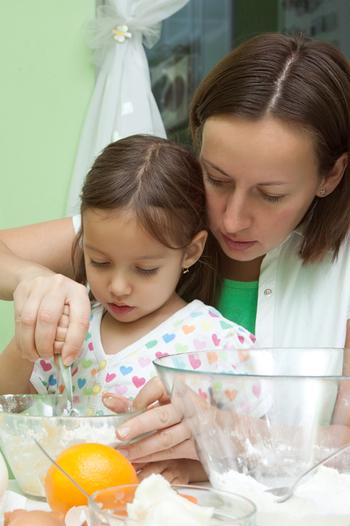Bake your cake and eat it too
Duration/age

Your child can learn a lot when cooking with you. Why not make a cake together?
What does the recipe ask for? Do you have all the ingredients?
Can you see if we have some milk and 4 eggs in the fridge? How much flour do we have? Is the jar full or getting empty?
While you are making the cake, read out the recipe for your child to follow. Show them the numbers and words in the recipe.
We need 2 cups of flour in the bowl. Can you measure 1 cup of flour, and then 1 more. How many eggs does the recipe say we need?
Hold your child’s hand as they stir the mixture. You might notice how the mixture changes as you stir it and as you add ingredients. Talk about why you need to grease the cake tin and how much mixture to put in. Do you fill it to the top or just half way?
Talk about how hot the oven needs to be so the cake will cook well. Show your child how you set the temperature. How long will you need to bake the cake for? If you have a timer, set that with your child too.
When it is time to take the cake out of the oven you can test it to make sure it is cooked. Just touch the top lightly…if it bounces back it is cooked. Careful, it smells delicious, but it’s hot!
Materials you will need
- Bowls
- Oven
- A recipe
- Cake tin
- Mixer or spoon
- Flour, eggs, milk, butter, sugar
Alternative tools
- Cake mix
Skills this activity improves
Why does this matter?
As you bake a cake together children are learning lots of numeracy concepts. They are learning about measurement as they add ingredients. They are also learning about measuring time and temperature as the cake bakes.
As they measure out ingredients and stir the mixture they will be developing motor skills.
While watching the mixture change as ingredients are added and then when the cake has baked, children will be developing their observation skills.
There are many words to do with cooking and baking, and as you use them with your child they will be developing their vocabulary.
What does this lead to?
When children have lots of real world experiences, like cooking, the concepts they are learning make sense for them. They will develop a sense of measurements, weights and volume.
Motor skills help children with writing and with coordination.
Observation helps children to notice small differences. This is essential when they are learning to read and how to tell the difference between an o and an a, for example.
Having a rich vocabulary helps children when they are learning to read, and later when they communicate with others.
Language to use
- Cake, bake, make
- Flour, eggs, sugar, milk, butter
- Bowl, spoon, mixer, whisk
- Measure
- Cup, tablespoon, teaspoon
- Grams, millilitres
- Mix, stir, fold, whisk
- Grease, line
- Pour, smooth
- Oven, temperature, hot, stand back
- Time, timer, minutes, tick
Questions to use
- What kind of cake will we bake today?
- Should we make a round cake or a square cake?
- Can you pour the milk to the top of the cup?
- How many eggs does the recipe say we need?
Useful tips
- You might also like to take a look at the A freckle here, some sprinkles there activity.
- You could use a packet cake mix to make a cake at home.
- If you don't have a recipe look for one on the internet or in a magazine.
- For safety information, especially about burns and scalds, see Living with toddlers or visit www.parenting.sa.gov.au
- Remember to talk to your child in your home language.
More ideas
- Try making cakes that are different sizes and shapes. Try a rectangle cake or a round cake. You could make one big cake or many little cupcakes. Some people make small fruitcakes in clean food tins. You will need to vary the cooking time depending on the size or shape of the cake you make.
- You could ice the cake when it is cool. Talk about what colour icing you want to make and how you want to decorate the cake.
Variation by age
Birth to 2 year olds
- Mud pies and sand cakes are great fun for children. If you have a sandpit just add water to make ‘cakes’. You could make your own small sand or mud patch by adding water to some sand or soil in a large plastic bowl. Give your child some bowls and spoons to make their own cakes.
3 to 5 year olds
- Painting with icing. Make or buy a plain cake and cut it into small squares with your child. Mix up some plain icing - just icing sugar and a little water - until it is the right consistency for spreading. Put the icing into several small bowls and then let your child put a small amount of food colouring in each one. Use the icing to ice the squares of cake and talk about the different colours.
Questions to ask
- Who is your cake for?
- What kind of cake are you making today?
- What could you use to decorate your cake?
Questions to ask
- What colours would you like to make? If we mix red and blue what will we get?
- What does that one look like?
- Can you see anything else that is red?
Language to use
- Mud, sand
- Wet, dry, moist, damp
- Mix, stir
- Cook, cool
Language to use
- Cut, slice
- Spread, ice
- Red, light blue, green, dark yellow
- This is purple like your socks.


